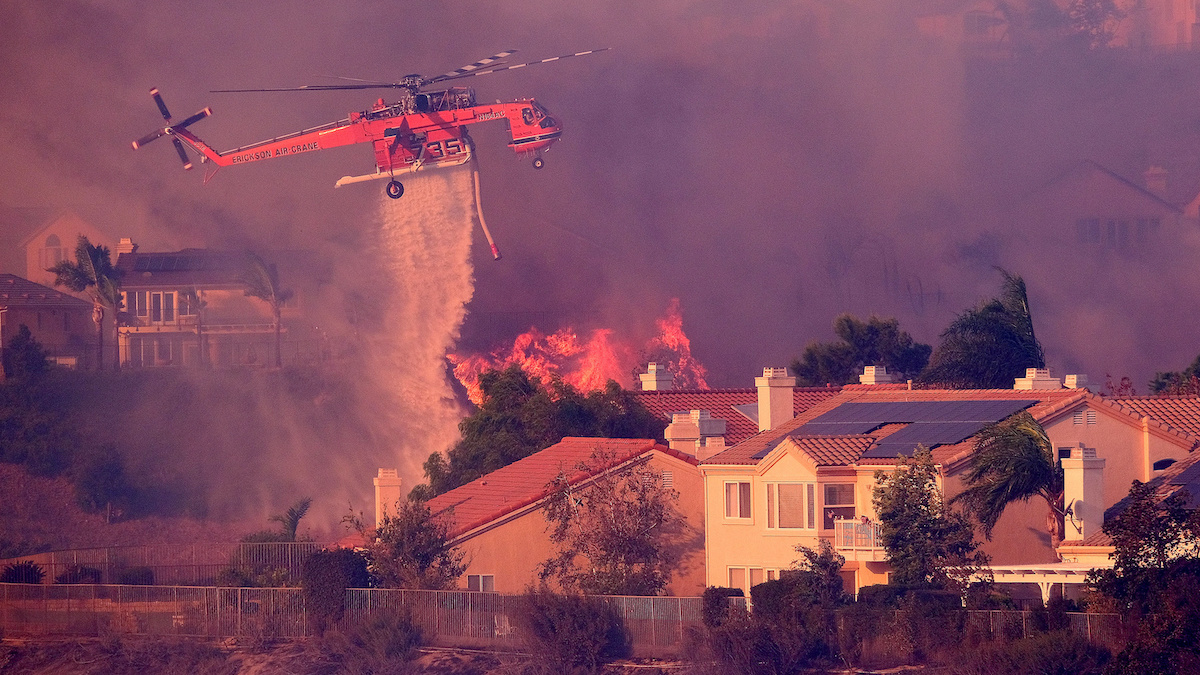

A skycrane makes a water drop on flames in Porter Ranch, California on Oct. 11, 2019. Dean Musgrove / Los Angeles Daily News / Getty Images
The climate crisis cost countries around the world billions of dollars in extreme weather events in 2019, according to the latest annual tally from UK charity Christian Aid.
The report, published Friday, identified seven disasters that cost billion or more, and 15 disasters that cost more than billion, according to a press summary. That’s up from last year, when the group highlighted 10 disasters that cost more than billion and four that cost more than billion.
“If anything 2019 saw even more profound extreme weather events around the world than last year, including wildfires from the Amazon through to the Arctic, devastating out-of-season, simultaneous wildfires in California and Australia, winter heat waves and devastating superstorms,” Pennsylvania State University climate scientist professor Michael Mann said in the press release. “With each day now we are seemingly reminded of the cost of climate inaction in the form of ever-threatening climate change-spiked weather extremes.”
The group wrote that they likely underestimated the true cost of the disasters they studied because in some cases they could only account for insured losses, not uninsured losses or lost productivity. The report was also published before the cost of Australia’s devastating wildfire season could be calculated, The Guardian pointed out.
Here are the seven climate-related disasters that cost billion or more in 2019, according to the report.
- California Wildfires, Billion: The costliest extreme weather events of 2019 included in the report were the wildfires that burned through California in October and November. The area burned in California each year has quintupled since 1972, mostly because higher temperatures have dried forests, creating more fuel for the flames.
- Typhoon Hagibis in Japan, Billion: Typhoon Hagibis hit Japan in October with winds of up to 225 kilometers (approximately 140 miles) per hour. It was one of the strongest storms to pummel the country in decades and killed 98 people. The storm also intensified at the fastest rate in 23 years, and warmer oceans have been linked to more intense storms.
- Midwest and Southern Flooding, .5 Billion: The flooding that devastated the Midwestern and Southern U.S. between March and June has been linked to climate change. Warmer air can hold more moisture, increasing the likelihood of extreme rain and snow falls.
- Flooding in China, Billion: Heavy rain from June to August led to massive flooding in southern and eastern China, killing at least 300 people. More rain in China is expected to fall in heavy downpours because of the climate crisis, and parts of the country saw their highest rainfall tallies in almost 60 years.
- Hurricane Dorian, .4 Billion: The September hurricane was the second strongest storm on record in the Atlantic and it devastated the Bahamas, costing the country the equivalent of more than a quarter of its gross domestic product. Warmer ocean temperatures made it both more intense and wetter than it would have been otherwise, and led it to intensify more quickly.
- Typhoon Lekima in China, Billion: The typhoon that hit China in August was the fifth most intense to hit the country since 1949. It killed 101 people and was the second most expensive storm in China’s history. Like Hagibis and Dorian, it also intensified quickly, a phenomenon linked to warmer temperatures.
- Flooding in North India, Billion: Flooding caused by the heaviest monsoon rains in 25 years swamped Northern India, Bangladesh and Nepal between June and October. The rains killed almost 1,900 people in India alone and displaced more than three million. Climate change makes more extreme rainfall more likely generally, and, in Northern India, rainstorms have increased 50 percent in frequency and 80 percent in duration.
The costliest events weren’t necessarily the most devastating or the deadliest. While the floods in Northern India claimed the most lives, Cyclone Idai, which slammed Mozambique, Zimbabwe, Malawi and Madagascar in March, had the next highest death toll. It killed 1,300 people and cost billion. In general, poorer countries suffered higher death tolls while wealthier countries suffered costlier disasters. Three of the four most expensive hit the U.S. and Japan.
Christian Aid said the report showed the importance of acting now to mitigate the climate crisis.
- 20 Reasons Why 2019 Gave Us Climate Hope - EcoWatch
- Climate Change Literature That Made Waves in 2019 - EcoWatch
- Climate Disasters Now Happening Weekly, UN Official Warns ...

 233k
233k  41k
41k  Subscribe
Subscribe 